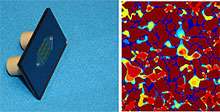Breaking down the bubbly: Micromodels redefine how bubbles characterize CO2 gas flow

One of the most noteworthy concerns for the U.S. Department of Energy is controlling atmospheric carbon dioxide to mitigate its effects on global climate and, in turn, energy consumption. Geological formations, such as the Mt. Simon Sandstone Reservoir in the Illinois basin, offer potential storage for captured CO2—the challenge is knowing that, once packed in saline aquifers or depleted oil and gas fields, the CO2 will stay there. Using EMSL's Microfabrication and Subsurface Flow and Transport capabilities, as well as fluorescence microscopy and image analysis, scientists crafted a micromodel in a silicon wafer to mimic Mt. Simon sandstone's low-permeability pore structure.
The unique pore-scale model can be operated in supercritical conditions, allowing flow properties of exsolved, or separated, CO2 and carbonated water to be observed during depressurization in reservoir pressure and temperature conditions (9 MPa and 45°C, respectively)—not unlike when, upon opening, CO2 (and potentially H2O) escape from a soda bottle. The work showed how interfacial tension and pore geometry affect bubble formation, morphology, and mobility as CO2 exsolves into gas. Contrary to existing definitions of critical gas saturation—the onset of gas production—bubbles formed long before gas flow was detected downstream in the micromodel. At this newly defined minimum saturation point, a snap-off mechanism produced mobile gas bubbles along the model's water flow paths, transporting the dispersed exsolved gas and leading to intermittent gas flow. The mobile bubbles do not interact very well, blocking water flow and repressing a mobile gas phase. With such low permeability and the flow barrier created from exsolved CO2, geological CO2 sequestration may prove a viable, potentially favorable, storage option. Moreover, this research could evolve to examine how CO2 may or may not enhance oil recovery methods currently used by the oil and gas industry.
To learn more about the work being done analyzing CO2 bubbles and geological sequestration at EMSL, check out "User Spotlight: The Escape Potential of CO2" at .
More information: Zuo, L. et al. 2013. Micromodel Investigations of CO2 Exsolution from Carbonated Water in Sedimentary Rocks. Advances in Water Resources 53:188-197. .
Provided by Environmental Molecular Sciences Laboratory
















